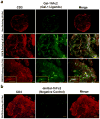Galectin-1 research in T cell immunity: past, present and future
- PMID: 22019770
- PMCID: PMC3266984
- DOI: 10.1016/j.clim.2011.09.011
Galectin-1 research in T cell immunity: past, present and future
Abstract
Galectin-1 (Gal-1) is one of 15 evolutionarily conserved ß-galactoside-binding proteins that display biologically-diverse activities in pathogenesis of inflammation and cancer. Gal-1 is variably expressed on immune cells and endothelial cells, though is commonly found and secreted at high levels in cancer cells. It induces apoptosis in effector T cells through homodimeric binding of N-acetyllactosamines on membrane glycoproteins (Gal-1 ligands). There is also compelling evidence in models of cancer and autoimmunity that recombinant Gal-1 (rGal-1) can potentiate immunoregulatory function of T cells. Here, we review Gal-1's structural and functional features, while analyzing potential drawbacks and technical difficulties inherent to rGal-1's nature. We also describe new Gal-1 preparations that exhibit dimeric stability and functional activity on T cells, providing renewed excitement for studying Gal-1 efficacy and/or use as anti-inflammatory therapeutics. We lastly summarize strategies targeting the Gal-1-Gal-1 ligand axis to circumvent Gal-1-driven immune escape in cancer and boost anti-tumor immunity.
Copyright © 2011 Elsevier Inc. All rights reserved.
Figures



References
-
- Yang RY, Rabinovich GA, Liu FT. Galectins: structure, function and therapeutic potential. Expert Rev Mol Med. 2008;10:e17. - PubMed
-
- Rabinovich GA, Toscano MA. Turning 'sweet' on immunity: galectin-glycan interactions in immune tolerance and inflammation. Nat Rev Immunol. 2009;9:338–52. - PubMed
-
- Camby I, Le Mercier M, Lefranc F, Kiss R. Galectin-1: a small protein with major functions. Glycobiology. 2006;16:137R–157R. - PubMed
Publication types
MeSH terms
Substances
Grants and funding
LinkOut - more resources
Full Text Sources
Other Literature Sources
Research Materials
Miscellaneous

